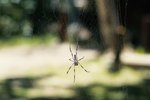
Some spiders are poisonous while others may help kill pests in your yard. You can differentiate potentially dangerous brown window spiders from helpful orb-weaver spiders by distinctive adaptations in life cycles, what they eat, habitat, venom and general lifestyle.
Physical Appearance
The coloration of the brown widow spider consists of a mottling of tan with dark-brown or almost black variable markings. When mature, brown widow female spiders have a dorsal longitudinal abdominal band of color with three diagonal bands on each line. Beneath its abdomen, the brown widow spider has an hourglass marking that is shaded orange. The orb-weaver spider has a large family made up of many species, which make it difficult to identify them. However, they all have smoothed abdomens and tiny heads.
Life Cycle
Brown widow spiders reproduce rapidly, with females laying up to 5,000 eggs each season. The eggs are attached beneath the abdomen and take 20 to 30 days to hatch. Females can live for about three years but males live for less than a year. Orb-weaver spiders have a very short lifespan. The male dies after mating and the female dies after laying eggs. The female orb-weaver spider lays about 100 to 300 eggs. The orb-weaver spider wraps its eggs in a egg sac and attaches it beneath a leaf. The eggs hatch to larvae after a couple of weeks but remain in the sac until winter is over.
Habitat
Brown widow spiders thrive in tropical climates and are mostly found in the Southeast region of the United States. The spider builds its web in protected sites around homesteads and woody vegetation. Various species of orb-weaver live in different climates all over the world. They build their webs in either zigzags or the circular patterns from which they take their common name.
Bites
Both brown widows and orb-weavers are venomous. A brown widow's bite isn't nearly as serious as a black widow's, but it can be painful, and may pose a threat to some bite victims; if you are bitten by a brown widow, seek medical attention. An orb-weaver spider’s bite is not dangerous to humans and has similar effects to a bee sting. Neither spider is prone to bite, and both are more likely to run away if they feel threatened.
References
Photo Credits
-
Jupiterimages/Photos.com/Getty Images
Writer Bio
Kendal Elizabeth has been a professional writer and editor since 2001. She has specialized in writing pet-related topics, home decor and gardening. Her work has appeared on several online and offline publication. Elizabeth holds a Bachelor of Science in Animal Science with a minor in marine biology from Cornell University.


